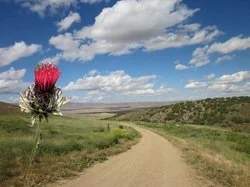Transitions: How do you approach them?
Change is in the air! Many members of my community are birthing new things, from babies to projects to new family structures. The energy feels full of possibility. Old identities and roles are melting away and new ways of being are emerging.
Transition is a powerful time - it's the pregnant pause between letting go of one role and stepping into something new. If given attention and space, transitions can be full of magic and possibility. There's often an impulse to rush through transitions - to get to where we think we're supposed to go (I know this feeling all too well). Or we can linger in transitions, finding it difficult to move forward (also familiar to me!).
How do you approach transitions? Are they exciting, scary, to be moved through quickly?
Sitting in the murkiness of the unknown can be uncomfortable. However, if we pause and practice deep listening during transitions, we can better hear our inner wise-voice. From here, the next stage emerges naturally. Using simple tools, we can create what is needed to tap into the creative potential of transitions, while inspiring movement so we don't get stuck.
Simple ways to work with transitions:
Making Internal space - Using breath to create space in the body is a wonderful, easy way to create feelings of expansion and possibility. Close your eyes. Allow your awareness to drop to your center. Take a slow, full breath, allowing the belly and ribs to expand, feeling the space between each rib. On the next slow inhale, allow the back body to expand and broaden with the breath. The next inhale, allow the side body to expand to its fullest. Continue following the breath, experiencing expansion with the inhale and softening on the exhale. Play with this and notice the spaciousness that can arrive with this simple practice.
When the body has more internal space, we create an opportunity for new experiences. Next time you feel stuck in your thinking or way of being, change your body shape! Create space with the breath and notice what changes occur in your thinking. Is there space for new ideas and inspiration
Tending to External Space - Take a moment to notice your physical environment (spaces where you live, work and play). What experience do you have as you look around? Take it in and notice the feeling you have in the space. Is this feeling aligned with where you are now?
Notice the items that surround you - is there space for what wants to come next? Or does your space feel like a part of your past? Yesterday’s perfect fit may today’s not-quite-right. Sometimes a simple letting go is needed to create space for the new. (See Endings: Possibility for Liberation post for ways to let go).
Make micro-movements. Feeling stuck in a transition? Don't know what's coming next or what direction to head? Doesn't matter - pick one small task and do it. If it's not right for you, you'll know soon enough. You can always change your direction, but sometimes we just need to start moving.
When you've created more internal and external space, you've created an openness for your inner wisdom to come through. When you make micro-movements, you get additional information as to the next right step for you. This is a great time to ask for what you need. Whether you're seeking general direction, or more specific guidance, ask for it and trust the answers will come from the wise, essential self that is You. The answers are there, but it is up to us to hear them.
May you have a glorious day playing, exploring and creating in your new-found spaciousness.
A quote I come back to a lot these days:
"Life is like riding a bicycle. To keep your balance, you must keep moving." Einstein

